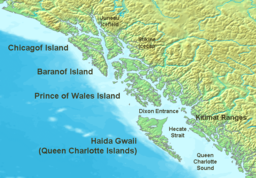Prince of Wales Island (Alaska)
| Prince of Wales | |
| Prince of Wales Archipelago | |
| Island | |
|
Prince of Wales Island (Alaska)
|
|
| Country | United States |
|---|---|
| State | Alaska |
| Borough | The Unorganized Borough |
| Census Area | Prince of Wales-Hyder (CA) |
| Borders on | Ketchikan Gateway |
| Elevation | 0 m (0 ft) |
| Coordinates | 55°37′55″N 132°54′27″W / 55.63194°N 132.90750°WCoordinates: 55°37′55″N 132°54′27″W / 55.63194°N 132.90750°W |
| Highest point | |
| - location | Neversummer ridge(Alaska) |
| - elevation | 3,996 ft (1,218 m) |
| Lowest point | |
| - elevation | 0 ft (0 m) |
| Length | 135 mi (217 km) |
| Width | 45 mi (72 km) |
| Area | 2,577 sq mi (6,674 km2) |
| Timezone | AKST (UTC-9) |
| - summer (DST) | AKDT (UTC-8) |
| ZIP code | 99901 ... 99950 |
| Area code | +1 907 |
| USGS GNIS | 1424651 |
| Topo map | USGS Alaska |
Prince of Wales Island is one of the islands of the Alexander Archipelago in the Alaska Panhandle. It is the fourth-largest island in the United States (after Hawaii, Kodiak Island, and Puerto Rico) and the 97th-largest island in the world.
The island is 135 miles (217 km) long, 45 miles (72 km) wide and has an area of 2,577 sq mi (6,674 km2), about 1/10 the size of Ireland and slightly larger than the state of Delaware. Approximately 4,000 people live on the island. Craig is the largest community; founded as a saltery in the early 20th century, it has a population of 1,000. Some 750 people live in Klawock, a long-established village that grew with the fishing industry. Hollis was a boom and bust mining town from 1900 to about 1915. Abandoned, it was re-established as a logging camp in the '50s. It now has a population of 100 and is the location of the ferry terminal.
Mountain peaks, all but the tallest of which were buried by Pleistocene glaciation, reach over 3,000 feet (914 m). Fjords, steep-sided mountains, and dense forests characterize the island. Extensive tracts of limestone include karst features such as El Capitan Pit, at 598.3 feet (182.4 m), possibly the deepest vertical shaft in the United States.
Moist, maritime conditions dominate the weather.
The Tongass National Forest covers most of the island. Within the forest and on the island are the Karta River Wilderness and the South Prince of Wales Wilderness. Many of its wildlife, such as the Prince of Wales flying squirrel (Glaucomys sabrinus griseifrons), are found nowhere else.
...
Wikipedia

